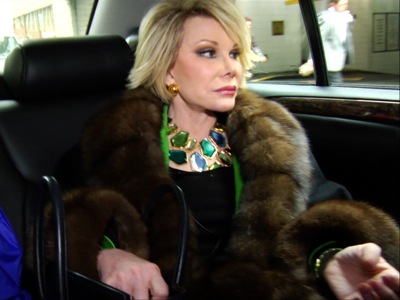Crafting Motifs in Documentary Films
I just saw an enjoyable documentary biography, “Joan Rivers: A Piece of Work”, which made use of a great motif…a datebook!
Before explaining how you can use a motif, let me first mention that I have (at the time of this writing) two slots left in my new coaching program. You can find out more about the New Doc Inner Circle, which runs August 2010 to January 2011 at:
https://newdocediting.com/land/innercircle/
Now…what exactly is a motif? And why would you want to edit one into a documentary film?
You’ve probably heard of the word “motif” in terms of novels or other literary works. In Arthur Miller’s “Death of a Salesman,” the flute is a motif conveying a bucolic rural setting. Simply put, a “motif” is a recurring object or place or sometimes a statement which symbolizes the film’s topic. In other words, a motif is a vehicle through which the film’s narrative theme is conveyed.
For example, in the recent documentary “Joan Rivers: A Piece of Work”, Joan’s datebook is a recurring symbol for her dedication to her work. Early in the film, Joan is desperate to find work. She jokes about how she needs to put her sunglasses on when looking at her date book, because of the glaring white space. The editor weaves the datebook throughout the film. By the end of the documentary, after Joan wins “Celebrity Apprentice”, her very full datebook conveys not only the flood of gigs she’s getting, but also her signature, almost obsessive love affair with work.
In the documentary “Complaints of a Dutiful Daughter” by filmmaker Deborah Hoffmann, several motifs appear to convey what it must be like to deal with Alzheimer’s disease. Hoffmann, the filmmaker and the protagonist of this moving personal film, cleverly weaves in images of clocks to symbolize the passage of time, “white-out” to symbolize a fuzzy memory, and suitcases to convey her ailing mother’s move from her home into a nursing home.
When and how do you develop a motif for your film? Ideally, during production. Stay alert to objects that can stand in for the film’s larger meaning. If you notice such an object early on, you can not only direct your cinematographer to shoot this object in an interesting, artful ways, but you can also ask your characters to expound on the object’s larger meaning. For example, Joan Rivers’ jokes about her datebook get at how this common object can embody a larger meaning.
Sometimes you may not notice a possible motif until postproduction. Again, you want to stay alert to the possibility or you may miss it. In the entertaining documentary “No Impact Man”, Collin Bevans sets out on a quest to survive a year with his family in New York City without having any impact on the environment. In my humble opinion, his wife’s agony in giving up her cherished Starbucks drink (the disposable container is a no-no) could have been pushed a bit further to become a motif symbolizing our society’s addiction to being “wired”.
Sometimes a motif is a recurring statement or a recurring element of the natural landscape. For example, in the documentary “Same River Twice” by Robb Moss, the river itself is a motif for the passage of time, which is the theme of this engaging documentary about aging baby boomers.
Have fun with developing a motif. Gather your film’s team for coffee and spend an hour brainstorming about possible cinematic/visual and sonic/audio candidates for motifs. Not every viewer will register the motif consciously, but this literary invention easily translates into you film’s ability to convey themes subconsciously.
